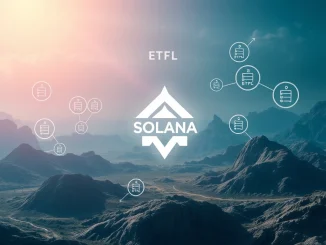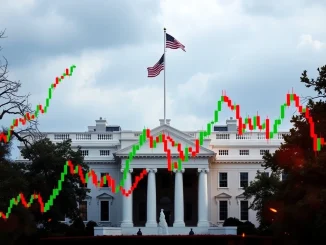
In a groundbreaking move that has sent ripples across both traditional finance and the digital asset space, Upexi Inc. (NASDAQ: UPXI) has dramatically expanded its Solana (SOL) treasury. This strategic acquisition, totaling an additional $16.7 million in SOL, underscores a pivotal shift in the company’s corporate strategy and has significantly impacted Upexi stock performance.
Upexi’s Bold Leap into Crypto Treasury Management
Upexi announced the purchase of 83,000 SOL for $16.7 million in early July 2025. This latest acquisition elevates its total Solana holdings to a staggering 1.9 million tokens, valued at approximately $381 million as of July 22. This follows a prior acquisition of 100,000 SOL at $176.77 per token, bringing total holdings to 1.82 million SOL, valued at $331 million. The combined investment now represents a cumulative cost of $273 million for 1.8 million SOL, boasting an impressive unrealized gain of $58 million thanks to Solana’s recent price appreciation.
This treasury expansion was funded through a $200 million issuance of shares and convertible bonds, marking Upexi’s third major capital infusion into Solana since April. Over half of its tokens were acquired at discounted prices and are locked under long-term holding strategies. Upexi’s holdings are projected to generate up to $26 million in annual staking revenue at the current 7.3% annual percentage yield (APY).
Upexi CEO Allan Marshall emphasized this move as “the first instance of altcoin treasury management in public markets,” positioning the firm as a bridge between traditional finance and digital assets.
What’s Driving the SOL Price Surge?
Solana’s price has seen a remarkable surge in recent months. As of July 23, SOL was trading at $198.33—a 47.6% increase over the past month and a 20% rise in the last week. Analysts attribute this significant momentum to the blockchain’s robust scalability and attractive staking yields, which have increasingly drawn institutional buyers.
A prominent cryptocurrency specialist known as “Christiaan” has even forecasted a potential price range of $400–$500 for SOL under current bullish trajectories, highlighting its strong technical indicators and positive market sentiment. Upexi’s aggressive accumulation aligns with its publicized policy of prioritizing Solana on its balance sheet, emphasizing the blockchain’s scalability and staking yields as key advantages.
The Rise of Institutional Crypto Adoption
Upexi’s strategy is a clear reflection of broader trends in institutional crypto adoption. Its Solana treasury now accounts for a substantial portion of its market value. The firm’s stock surged an impressive 28.5% intraday following the July 22 purchase announcement, and a staggering 67% in the week following the treasury expansion. This illustrates the immense potential for firms to capitalize on digital asset trends.
The average cost basis for Upexi’s 1.8 million SOL is approximately $151.67 per token, compared to a current valuation of $181.68. This discrepancy underscores both market optimism and the company’s ability to execute large transactions without significantly impacting Solana’s price. The firm’s approach has sparked discussions about the evolving role of corporate treasuries in crypto markets.
Upexi’s introduction of a “Basic mNAV” metric—a market value/SOL net asset value ratio—signals a data-driven approach to portfolio management. Additionally, its staking strategy could inspire other firms to explore similar models, leveraging blockchain technology for diversified revenue streams.
Navigating Risks and Future Outlook
While Upexi has not disclosed future purchase plans, its track record suggests a long-term holding horizon. However, this innovative strategy is not without its risks, including exposure to Solana’s inherent price volatility and the broader regulatory uncertainties within the crypto sector.
Solana’s recent rally has also intensified interest in projects leveraging its ecosystem. Trading volumes for SOL peaked at 3.77 million units during its July 22–23 surge, though institutional selling temporarily pushed the price below $200. The market’s response to Upexi’s strategy clearly underscores growing institutional adoption of Solana. As the sixth-largest digital currency by market cap, Solana’s robust yield and liquidity position it as a strategic asset for corporations seeking exposure to blockchain innovation.
Observers will undoubtedly monitor Upexi’s future actions and Solana’s price trajectory for further insights into the evolving intersection of traditional finance and decentralized markets.
Frequently Asked Questions (FAQs)
1. What is Upexi’s total Solana (SOL) holding after its recent purchases?
After its recent strategic acquisitions, Upexi’s total Solana holdings have reached 1.9 million tokens, valued at approximately $381 million as of July 22, 2025.
2. How is Upexi funding its Solana treasury expansion?
Upexi funded its treasury expansion through a $200 million issuance of shares and convertible bonds, marking its third significant capital infusion into Solana since April.
3. What is the projected annual staking revenue from Upexi’s SOL holdings?
Upexi’s Solana holdings are projected to generate up to $26 million in annual staking revenue, based on the current 7.3% annual percentage yield (APY).
4. How has Upexi’s stock performed following these Solana investments?
Upexi’s stock surged an impressive 28.5% intraday following the July 22 purchase announcement, and it has seen a remarkable 67% increase in the week following the treasury expansion.
5. What does Upexi’s strategy signify for institutional crypto adoption?
Upexi’s move is considered the first instance of altcoin treasury management in public markets, positioning the firm as a bridge between traditional finance and digital assets. It highlights a growing trend of institutional crypto adoption and could inspire other corporations to explore similar models for diversified revenue streams.



